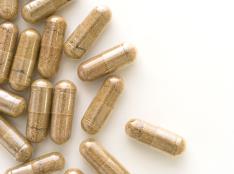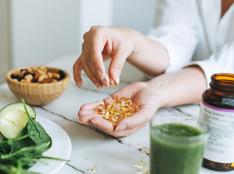Spring brings with it a plethora of delicious seasonal food. From asparagus to arugula, here are 10 spring vegetables everyone should try.
Arugula
1 of 11
Arugula is a versatile salad green that is low in calories with a half cup totaling to just two calories. Arugula is an excellent source thiamin, vitamin B6, zinc and fiber. It's best to mix arugula with other salad greens to balance its slightly bitter, peppery flavor.
Find more
nutrition tipsAsparagus
2 of 11
Asparagus is a perennial garden plant that is actually easy to grow at home. One pack of seeds will continue to yield for up to 25 years. Asparagus supplies?immune-boosting antioxidants such as vitamin C and beta-carotene. Asparagus also contains inulin, a type of carbohydrate, which acts as a prebiotic, feeding the healthy bacteria in your gut. Asparagus has 3 grams of fiber per cup, and 4 to 5 grams of protein per cup.
Find more
nutrition tipsFiddleheads
3 of 11
Fiddleheads are the young coiled leaves of the ostrich fern. When choosing fiddleheads, look for a tight coil and only an inch or two of stem. Fiddleheads are filled with antioxidants, omega-3 and omega-6 fatty acids, as well as iron, fiber, vitamin A and C. They can be served warm on toast or in a salad. Fiddleheads are versatile and easy to use. They have a mild taste reminiscent of asparagus with an added nutty bite.
Find more
nutrition tipsKiwi
4 of 11
Kiwi is known as the national fruit of China. Each kiwi has 56 calories and 3 grams of fiber. Kiwis contain more vitamin C than oranges, as much potassium as a banana and a generous amount of beta-carotene. When choosing kiwi, choose fruits with no bruises or soft spots. Fruits with wrinkles or signs of exterior damage are undesirable. You can even finish ripening kiwi at home for a juicier flavor. Kiwi skin is edible. In New Zealand, it's very common to eat kiwi raw, with the skin still on. Kiwi skin contains high levels of disease preventing flavonoids, fiber and antioxidants.
Find more
nutrition tipsMint
5 of 11
Mint is rich in vitamins A and C and contains a small amount of B2. Mint also contains minerals such as manganese, copper, iron, potassium and calcium. Mint can be used medicinally to improve digestion. It also may inhibit the growth of many types of bacteria. To lengthen the life of your mint, store it in a container of water, stems down, with a plastic bag loosely covering the top, change the water every two days and it will stay fresh for up to a week. Add chopped mint to rice, chickpea, couscous or beans.
Find more
nutrition tipsParsley
6 of 11
Parsley is a relative of celery and is the world's most popular herb. Parsley may enhance the body's absorption of the bone strengthening mineral manganese. Parsley contains certain oils, which may help in neutralizing particular types of carcinogens. Parsley pairs well with meat, salad and soups.
Find more
nutrition tipsPeas
7 of 11
Peas are a wonderful choice for those who follow a low glycemic index diet. They are a good source of vitamin C and cholesterol-lowering soluble fiber. They also are unique for their phytonutrients called saponins. Peas are an environmentally friendly item to grow in your garden. With the help of bacteria in the soil, peas are able to take nitrogen gas from the air and convert it into a usable form. This process increases nitrogen available in the soil without the need for added fertilizer.
Find more
nutrition tipsRadishes
8 of 11
Good things come in small packages. Radishes are nutritional powerhouses full of vitamin C, potassium, and fiber. Radishes are a root plant that has a pungent or sweet taste. They can be found white, red, purple or black in color. They also can be found long, cylindrical or round in shape. Radishes are known for their detoxification capabilities, constipation relieving abilities and anti-inflammatory capabilities.
Find more
nutrition tipsRhubarb
9 of 11
Rhubarb has a tart flavor and pairs well with strawberries, apples, cherries and berries. It can be canned, frozen, baked in pies, cobblers and breads. When purchasing rhubarb, choose thick, firm stalks with no wrinkling or other signs of drying. If there are leaves on the stalks, they should be fresh and not wilted. Rhubarb is known for its diuretic and anti-inflammatory properties. Rhubarb contains about one-third of your daily calcium needs, as well as potassium, folate and iron. The red stalks of rhubarb are full of the immune-boosting photochemical, anthocyanin.
Find more
nutrition tipsMorel Mushrooms
10 of 11
Mushrooms have been frequently studied because of their cardio protective levels. They are high in copper, vitamin E, and potassium. Morel mushrooms are also good for prostate cancer prevention because of their levels of selenium and niacin. Most importantly, mushrooms are known to boost the immune system, which can be beneficial in the damp spring season.







Discuss This Article